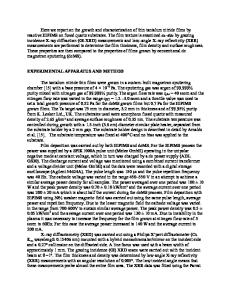An introduction to thin film processing using high-power impulse magnetron sputtering
- PDF / 711,634 Bytes
- 13 Pages / 584.957 x 782.986 pts Page_size
- 75 Downloads / 900 Views
gh-power impulse magnetron sputtering (HiPIMS) is a promising sputtering-based ionized physical vapor deposition technique and is already making its way to industrial applications. The major difference between HiPIMS and conventional magnetron sputtering processes is the mode of operation. In HiPIMS the power is applied to the magnetron (target) in unipolar pulses at a low duty factor (,10%) and low frequency (,10 kHz) leading to peak target power densities of the order of several kilowatts per square centimeter while keeping the average target power density low enough to avoid magnetron overheating and target melting. These conditions result in the generation of a highly dense plasma discharge, where a large fraction of the sputtered material is ionized and thereby providing new and added means for the synthesis of tailor-made thin films. In this review, the features distinguishing HiPIMS from other deposition methods will be addressed in detail along with how they influence the deposition conditions, such as the plasma parameters and the sputtered material, as well as the resulting thin film properties, such as microstructure, phase formation, and chemical composition. General trends will be established in conjunction to industrially relevant material systems to present this emerging technology to the interested reader.
I. INTRODUCTION
The concept of plasma-based physical vapor deposition (PVD) is today widely used for depositing thin films. PVD is a general term describing how films are deposited by the condensation of a vaporized form of a material onto any surface. The vapor of the thin film material is created by physical means from a solid deposition source. One such PVD method is sputter deposition,1 which has proven to be a robust and upscalable coating method. The most commonly used tool for sputter deposition is magnetron sputtering,2,3 which essentially is a diode sputtering configuration where a magnet pack is placed behind the target (cathode) to better confine the plasma close to the sputtering region. High-power impulse magnetron sputtering (HiPIMS) or sometimes referred to as high power pulsed magnetron sputtering (HPPMS) introduced by Kouznetsov et al.4 in 1999 is a promising technique for improving magnetron sputtering by the addition of pulsed power technology.5 To distinguish this technique from other pulsed magnetron processes, we use a similar definition as that of Anders6: HiPIMS is pulsed magnetron sputtering, where the peak power exceeds the time-averaged power by typically two orders of magnitude. In addition, the HiPIMS technology has recently been industrially upscaled by several big a)
Address all correspondence to this author. e-mail: [email protected] DOI: 10.1557/jmr.2012.8 780
J. Mater. Res., Vol. 27, No. 5, Mar 14, 2012
coating companies under various acronyms, which is a promising first step toward implementing it in common thin film processes. The interest of this technique has thus increased tremendously during the last 10 years, also shown by the steady increase of publications, re
Data Loading...











